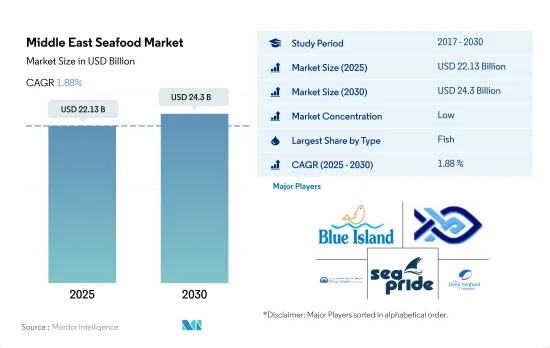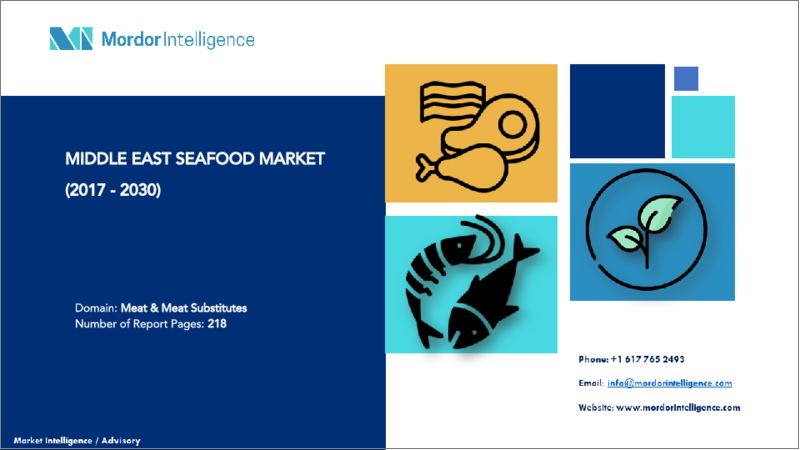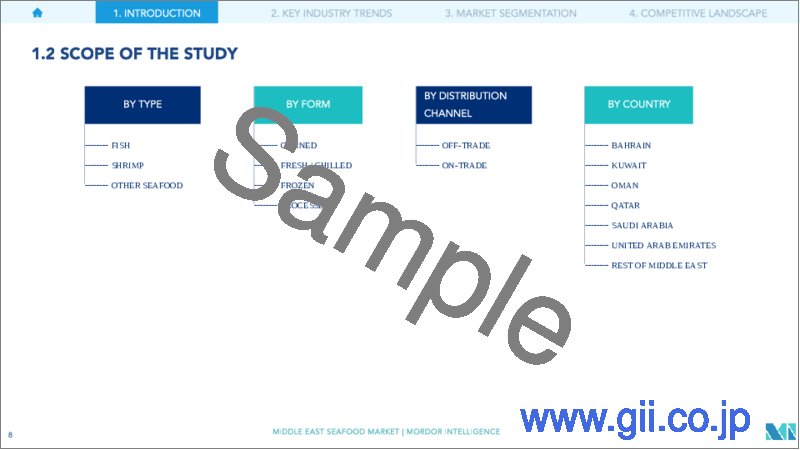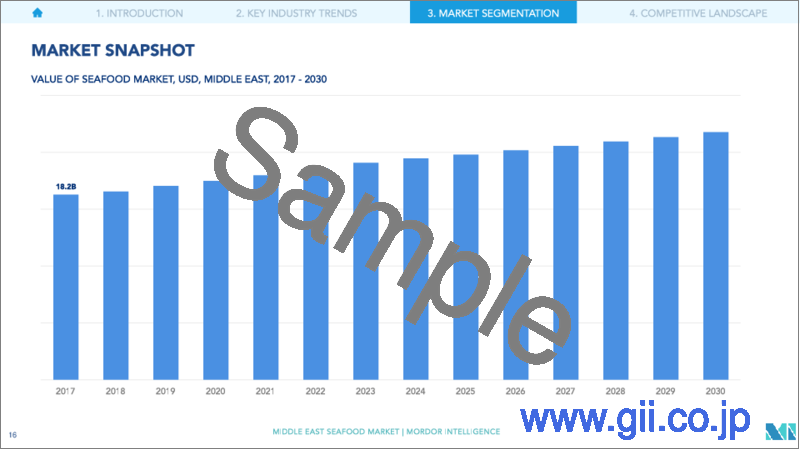|
|
市場調査レポート
商品コード
1692053
中東の水産物:市場シェア分析、産業動向、統計、成長予測(2025年~2030年)Middle East Seafood - Market Share Analysis, Industry Trends & Statistics, Growth Forecasts (2025 - 2030) |
||||||
カスタマイズ可能
適宜更新あり
|
|||||||
| 中東の水産物:市場シェア分析、産業動向、統計、成長予測(2025年~2030年) |
|
出版日: 2025年03月18日
発行: Mordor Intelligence
ページ情報: 英文 218 Pages
納期: 2~3営業日
|
全表示
- 概要
- 目次
中東の水産物市場規模は2025年に221億3,000万米ドルと推定・予測され、2030年には243億米ドルに達し、予測期間中(2025年~2030年)のCAGRは1.88%で成長すると予測されています。

サウジアラビアが戦略的投資とパートナーシップの支援で地域市場を独占
- 2022年、魚は他のすべての水産物の中で金額・数量ともに最大の市場シェアを占めました。販売額は2017年~2022年にCAGR 2.37%で成長しました。国民の大多数における健康意識の高まりと、コレステロール成分を添加しない栄養とタンパク質が豊富な食事への嗜好が、消費者がイワシ、サーモン、マグロのような様々な種類の魚により多くの支出をすることにつながっています。中東には広大な砂漠地帯があるほか、何マイルにもおよぶ海岸線があり、これが地元漁業の成長に役立っています。
- 予測期間中、中東ではエビが金額・数量ともに最も急成長する水産物分野となる見込みです。エビのほとんどは、インド、パキスタン、中国などのアジア諸国から輸入されています。エビは、タンパク質が豊富な減量食を選ぶ消費者にとって理想的な選択肢の一つです。中東では肥満が喫緊の課題となっており、クウェート、ヨルダン、サウジアラビアでは2023年時点で人口の25%以上が肥満と認定されています。
- サウジアラビアは同地域で最も重要な国のひとつであり、調査期間中の市場において金額・数量ともにトップクラスのシェアを占めています。同国はビジョン2030の一環として国家水産開発プログラムを立ち上げ、2022年に40億米ドルの資金を調達しました。この資金は、内陸漁業養殖のためのインフラ増強と労働力開発のために調達されました。アラブ首長国連邦は、UAE気候変動・環境省、アブダビ国営石油会社、エミレーツ国営石油会社と提携し、2022年に操業コストを削減するために漁業部門への燃料補助金を提案しました。
水産物生産への民間投資の増加が地域市場の需要を牽引
- アラブ首長国連邦は中東の水産物市場のリーダーです。同国の一人当たりの水産物消費量は増加しており、2021年には25.50kgに達し、オマーンの29.01kgに次ぐ第2位となります。水産物への需要は、所得水準が上昇し、魚に対する食欲が高まっている人口の拡大が牽引しています。首長国の人口の90%近くは移民で占められており、移民の母国では典型的な食事に水産物が含まれることが多いです。アラブ首長国連邦ではインド人が全人口の40%以上を占め、インドネシア人、バングラデシュ人などがこれに続きます。
- サウジアラビアは、2025年までに30万トン、2030年までに60万トンの魚を生産する予定です。養殖業のプレハーベスト、生産、ポストハーベスト分野では、こうした取り組みの結果、民間部門の投資が急増しています。サウジアラビアは、アジア太平洋養殖センターネットワーク(NASA)との提携により、水産物の生産量も大幅に増加すると思われます。水産物の入手可能性が高まることで、地元の需要はさらに高まると予想されます。
- バーレーンは、予測期間中に金額ベースで5.11%の最速のCAGRで推移すると予測されます。バーレーンでは水産物が主要な食料品目を構成しているため、魚の養殖は政府が食料安全保障を確保するために依存している重要な産業です。2021年には、国の食料安全保障を確保する努力の一環として、農業生産と魚類養殖を強化する候補地として6区画が特定されました。この動きは、魚の生産において50~62%の自給率を達成することが期待されています。魚の養殖に投資することで、天然資源への負担を軽減したり、養殖場で育てた魚の稚魚を自然に放流してバーレーンの人口を回復させるなど、多くのメリットがあります。
中東の水産物市場の動向
各国政府による自給率向上への取り組みにより、同地域での生産は拡大が見込まれる
- サウジアラビアは中東最大の魚生産国で、2022年には44万6,977トンを生産します。サウジアラビアの魚生産量は2017年から2022年にかけて6.48%増加し、アラブ首長国連邦が2022年に287091.9747トンで続きます。魚の生産量は2021年から2022年にかけて徐々に増加したが、これは主に政府が漁業に力を入れているためです。政府は民間セクターを漁業に参加させる機会を増やしています。独自のプログラムである国家漁業開発プログラムは、漁業部門のGDPへの貢献度を高め、養殖部門の生産性を2030年までの15年間で段階的に60万トンに引き上げることを目標としています。漁業を支援するため、漁業アカデミーの地域センターも設立されました。生産能力を高めるための魚類の研究活動には8,000万米ドル以上が投資されました。
- UAEのような国は、湾岸協力会議(GCC)の中で一人当たりの年間魚消費量が最も多く、世界平均を50%近く上回っています。急速な経済成長にもかかわらず、UAEの地元漁業は乱獲されており、地元産の魚はUAEの消費量の8%しか占めていないです。
- 魚の生産量は2023年から2029年まで持続的に増加すると予測されています。民間部門からの支援と開発強化のための漁業の特定、利害関係者との新たなパートナーシップと漁業への補助金、資源担当者による3,000の漁業の開発は、2022年からの漁業の生産と生産性の向上に役立つ可能性があります。例えば、2021年にはNEOM CompanyとTabuk Fish Companyが、サウジアラビアのNEOM地域において地元での養殖生産を拡大し、新世代の養殖技術を適用する覚書に調印しました。
輸入依存度の高さから価格が上昇
- 2022年、アラブ首長国連邦の魚価はサウジアラビアやその他中東地域と比較して最も高く、その価格差は1トンあたり約4,022米ドルでした。この差は主に、サウジアラビア政府による燃料、インフラ、その他の関連コストへの補助金増によるものです。また、2,640kmの海岸線という利点もあります。2023年6月のアラブ首長国連邦(UAE)の魚の小売価格帯は、1kgあたり4~20米ドル、または1ポンド(lb)あたり1.81~9.07米ドルでした。中東の価格が上昇した主な理由は、需要が供給を上回ったためです。現地での魚の供給は減少し、2020年と2021年には天候不順により現地での生産が妨げられました。漁師が毎日魚の競りを行うシステムは、買い手が漁師と良い取引を行い、その商品をより高い価格で転売することを可能にし、その結果、消費者の魚の小売価格を直接的に上昇させる。
- 2021年から2022年にかけて、魚価は3,043米ドルから3,072米ドルへと約0.96%上昇しました。魚価の上昇は主に石油価格の上昇とインフレ率の上昇によるものです。この上昇を抑えるため、各国政府は救済策を打ち出しており、例えばUAE政府は国内の低所得世帯を支援する予算を倍増させました。サウジアラビアの国王は、直接現金給付と備蓄に53億3,000万米ドルを拠出すると発表しました。予測期間中、魚価は持続可能な成長率を記録する可能性があります。中東では、水産物の生産を強化するために多くの官民パートナーシップが結ばれています。サウジアラビアは8,000万米ドルを投じて研究開発を行い、マスタートレーナーとともに内陸での魚の養殖を開発し、生産量を増やす計画を立てています。
中東の水産物産業の概要
中東の水産物市場は断片化されており、上位5社で0.76%を占めています。この市場の主要企業は、次のとおりです。 Blue Island PLC, National Fishing Company K.S.C., Oman Fisheries Co. SAOG, Sea Pride LLC and The Deep Seafood Company(sorted alphabetically).
その他の特典
- エクセル形式の市場予測(ME)シート
- 3ヶ月のアナリストサポート
目次
第1章 エグゼクティブサマリーと主な調査結果
第2章 イントロダクション
- 調査の前提条件と市場定義
- 調査範囲
- 調査手法
第3章 主要産業動向
- 価格動向
- 魚
- エビ
- 生産動向
- 魚類
- 規制の枠組み
- サウジアラビア
- アラブ首長国連邦
- バリューチェーンと流通チャネル分析
第4章 市場セグメンテーション
- タイプ
- 魚
- エビ
- その他のシーフード
- 形態
- 缶詰
- 生鮮・冷蔵
- 冷凍
- 加工
- 流通チャネル
- オフ・トレード
- コンビニエンスストア
- オンライン・チャネル
- スーパーマーケットとハイパーマーケット
- その他
- オン・トレード
- オフ・トレード
- 国名
- バーレーン
- クウェート
- オマーン
- カタール
- サウジアラビア
- アラブ首長国連邦
- その他中東
第5章 競合情勢
- 主要な戦略的動き
- 市場シェア分析
- 企業情勢
- 企業プロファイル
- Albatha Group
- Almunajem Foods
- Blue Island PLC
- Enhance Group Holding Company Limited
- National Fishing Company K.S.C.
- Oman Fisheries Co. SAOG
- Sea Pride LLC
- The Deep Seafood Company
- Thomsun Group
- Yamama Al-Baida Gen. Trading & Cont. Est.
第6章 CEOへの主な戦略的質問
第7章 付録
- 世界概要
- 概要
- ファイブフォース分析フレームワーク
- 世界のバリューチェーン分析
- 市場力学(DROs)
- 情報源と参考文献
- 図表一覧
- 主要洞察
- データパック
- 用語集
The Middle East Seafood Market size is estimated at 22.13 billion USD in 2025, and is expected to reach 24.3 billion USD by 2030, growing at a CAGR of 1.88% during the forecast period (2025-2030).

Saudi Arabia dominates the regional market with the assistance of strategic investments and partnerships
- In 2022, fish occupied the largest market share by value and volume among all other seafood variants. The sales value grew at a CAGR of 2.37% during 2017-2022. The increasing health consciousness among the majority of the population and preference toward a nutrient and protein-rich diet without added cholesterol components is leading consumers to spend more on different varieties of fish like sardines, salmon, and tuna. Apart from hosting extensive desert lands, the Middle East comprises miles of coastline that assist in the growth of local fisheries.
- Shrimp is projected to be the fastest-growing seafood segment in the Middle East, both by value and volume, during the forecast period. Most of the shrimp is imported from Asian countries like India, Pakistan, and China. Shrimps are one of the ideal choices for consumers opting for a protein-rich weight loss diet. Obesity is a pressing issue in the Middle East, with Kuwait, Jordan, and Saudi Arabia having more than 25% of their population identified as obese as of 2023, expanding the opportunity for the shrimp industry to flourish in the region.
- Saudi Arabia is one of the most significant countries in the region, occupying one of the highest market shares by value and volume in the market during the study period. The Kingdom launched the National Fisheries Development Program as a part of its Vision 2030 to raise a fund of USD 4 billion in 2022. This fund was raised to increase infrastructure and develop the workforce for inland fisheries cultivation. The United Arab Emirates proposed fuel subsidies to its fishing sector to reduce operating costs in 2022, partnering with the UAE Ministry of Climate Change and the Environment, Abu Dhabi National Oil Company, and Emirates National Oil Company.
Increasing private sector investments in seafood production driving demand in the regional market
- The United Arab Emirates is the leader in the Middle Eastern seafood market. The country's seafood consumption per person has increased, reaching 25.50 kg in 2021, ranking second only to Oman's 29.01 kg. The demand for seafood products is being driven by an expanding population with rising income levels and a growing appetite for fish. Nearly 90% of the Emirati population comprises immigrants, and typical meals in these migrants' home countries often include seafood products. Indians make up over 40% of the total population in the United Arab Emirates, followed by Indonesians, Bangladeshis, etc.
- Saudi Arabia intends to produce 300,000 metric tons of fish by 2025 and 600,000 metric tons by 2030. The aquaculture industry's pre-harvest, production, and post-harvest segments have seen a sharp increase in private sector investments as a result of these initiatives. Saudi Arabia's partnership with the Network of Aquaculture Centers in Asia-Pacific (NASA) would also greatly increase its seafood production. The higher availability of seafood is expected to boost the local demand further.
- Bahrain is projected to register the fastest CAGR of 5.11% by value during the forecast period. Fish farming is a crucial industry that the government relies on to ensure food security, as marine products comprise key food items in Bahrain. In 2021, six plots of land were identified as candidates to boost agricultural production and fish farming as part of efforts to ensure the country's food security. The move is expected to achieve 50-62% self-sufficiency in fish production. Investing in fish farming has many benefits, such as reducing the pressure on natural resources and releasing fish fingerlings raised on farms into the wild to restock Bahrain's population.
Middle East Seafood Market Trends
Production in the region is anticipated to grow due to self-sufficiency initiatives implemented by governments
- Saudi Arabia is the largest fish producer in the Middle East, producing 446,977 tons of fish in 2022. Fish production in Saudi Arabia increased by 6.48% from 2017 to 2022, followed by the United Arab Emirates, with 287091.9747 tons in 2022. Fish production increased gradually from 2021 to 2022, mainly due to the government's focus on fisheries. Governments are boosting opportunities to involve the private sector in fisheries. A unique program, the National Fisheries Development Program, aims to enhance the fisheries sector's contribution to GDP and increase the productivity of the aquaculture sector to 600 thousand tons in stages from 15 years to 2030. Regional centers for fishing academies have also been established to support fisheries. Over USD 80 million was invested in the research activities of fish to enhance production capabilities.
- Countries like the UAE have the highest annual per capita fish consumption in the Gulf Cooperation Council (GCC), which is nearly 50% higher than the global average. Despite rapid economic growth, the UAE's local fisheries are overfished, and local fish account for only 8% of UAE consumption.
- Fish production is projected to increase sustainably from 2023 to 2029. Support from the private sector and identification of fisheries for enhanced development, new partnerships with stakeholders and subsidies for fisheries, and the development of 3,000 fisheries with resource persons may help increase the production and productivity of fisheries from 2022. For instance, in 2021, NEOM Company and Tabuk Fish Company signed a memorandum of understanding to expand local aquaculture production and apply the new generation of aquaculture technologies in the NEOM region of Saudi Arabia.
Prices are rising due to the high dependency on imports
- In 2022, the United Arab Emirates had the highest fish prices compared to Saudi Arabia and the Rest of the Middle East, with the price difference being around USD 4,022 per ton. The difference was mainly due to more subsidies on fuel, infrastructure, and other associated costs by the Saudi Arabian government. It also has the added advantage of a 2,640 km coastline. The retail price range for United Arab Emirates (UAE) fish in June 2023 was between USD 4 and USD 20 per kg or between USD 1.81 and USD 9.07 per pound (lb). The prices in the Middle East increased mainly due to high demand, which exceeded the supply. The local fish supply decreased, and local production was hampered due to unfavorable climatic conditions in 2020 and 2021. The system of daily auctions for fish sales by fishermen enables buyers to strike good deals with them and resell their goods at higher prices, thus directly increasing retail consumer fish prices.
- From 2021 to 2022, fish prices increased by around 0.96%, from USD 3,043 to USD 3,072. The rising fish prices are mainly due to increasing oil prices and rising inflation. To curb this increase, the governments are launching relief measures, such as the UAE government doubling the budget to support low-income families in the country. Saudi Arabia's King announced USD 5.33 billion for direct cash transfers and stockpiling. Fish prices may record a sustainable growth rate during the forecast period. Many public and private partnerships are being undertaken to enhance the production of fisheries in the Middle East. Saudi Arabia spent USD 80 million on research and planning to develop fish cultivation inland with master trainers to increase production, which may help with constant prices.
Middle East Seafood Industry Overview
The Middle East Seafood Market is fragmented, with the top five companies occupying 0.76%. The major players in this market are Blue Island PLC, National Fishing Company K.S.C., Oman Fisheries Co. SAOG, Sea Pride LLC and The Deep Seafood Company (sorted alphabetically).
Additional Benefits:
- The market estimate (ME) sheet in Excel format
- 3 months of analyst support
TABLE OF CONTENTS
1 EXECUTIVE SUMMARY & KEY FINDINGS
2 INTRODUCTION
- 2.1 Study Assumptions & Market Definition
- 2.2 Scope of the Study
- 2.3 Research Methodology
3 KEY INDUSTRY TRENDS
- 3.1 Price Trends
- 3.1.1 Fish
- 3.1.2 Shrimp
- 3.2 Production Trends
- 3.2.1 Fish
- 3.3 Regulatory Framework
- 3.3.1 Saudi Arabia
- 3.3.2 United Arab Emirates
- 3.4 Value Chain & Distribution Channel Analysis
4 MARKET SEGMENTATION (includes market size in Value in USD, Forecasts up to 2030 and analysis of growth prospects)
- 4.1 Type
- 4.1.1 Fish
- 4.1.2 Shrimp
- 4.1.3 Other Seafood
- 4.2 Form
- 4.2.1 Canned
- 4.2.2 Fresh / Chilled
- 4.2.3 Frozen
- 4.2.4 Processed
- 4.3 Distribution Channel
- 4.3.1 Off-Trade
- 4.3.1.1 Convenience Stores
- 4.3.1.2 Online Channel
- 4.3.1.3 Supermarkets and Hypermarkets
- 4.3.1.4 Others
- 4.3.2 On-Trade
- 4.3.1 Off-Trade
- 4.4 Country
- 4.4.1 Bahrain
- 4.4.2 Kuwait
- 4.4.3 Oman
- 4.4.4 Qatar
- 4.4.5 Saudi Arabia
- 4.4.6 United Arab Emirates
- 4.4.7 Rest of Middle East
5 COMPETITIVE LANDSCAPE
- 5.1 Key Strategic Moves
- 5.2 Market Share Analysis
- 5.3 Company Landscape
- 5.4 Company Profiles (includes Global level Overview, Market level overview, Core Business Segments, Financials, Headcount, Key Information, Market Rank, Market Share, Products and Services, and analysis of Recent Developments)
- 5.4.1 Albatha Group
- 5.4.2 Almunajem Foods
- 5.4.3 Blue Island PLC
- 5.4.4 Enhance Group Holding Company Limited
- 5.4.5 National Fishing Company K.S.C.
- 5.4.6 Oman Fisheries Co. SAOG
- 5.4.7 Sea Pride LLC
- 5.4.8 The Deep Seafood Company
- 5.4.9 Thomsun Group
- 5.4.10 Yamama Al-Baida Gen. Trading & Cont. Est.
6 KEY STRATEGIC QUESTIONS FOR SEAFOOD INDUSTRY CEOS
7 APPENDIX
- 7.1 Global Overview
- 7.1.1 Overview
- 7.1.2 Porter's Five Forces Framework
- 7.1.3 Global Value Chain Analysis
- 7.1.4 Market Dynamics (DROs)
- 7.2 Sources & References
- 7.3 List of Tables & Figures
- 7.4 Primary Insights
- 7.5 Data Pack
- 7.6 Glossary of Terms






